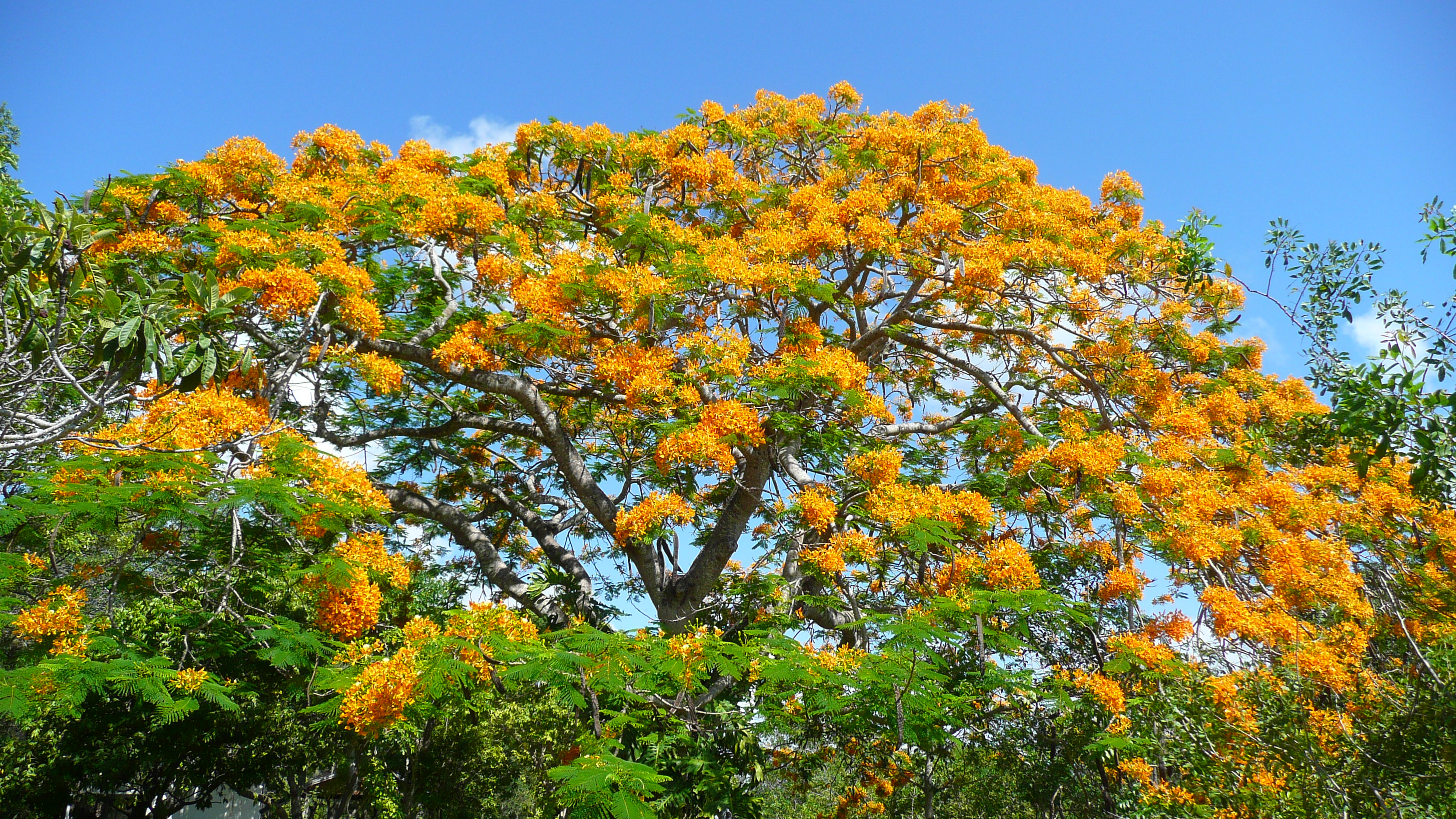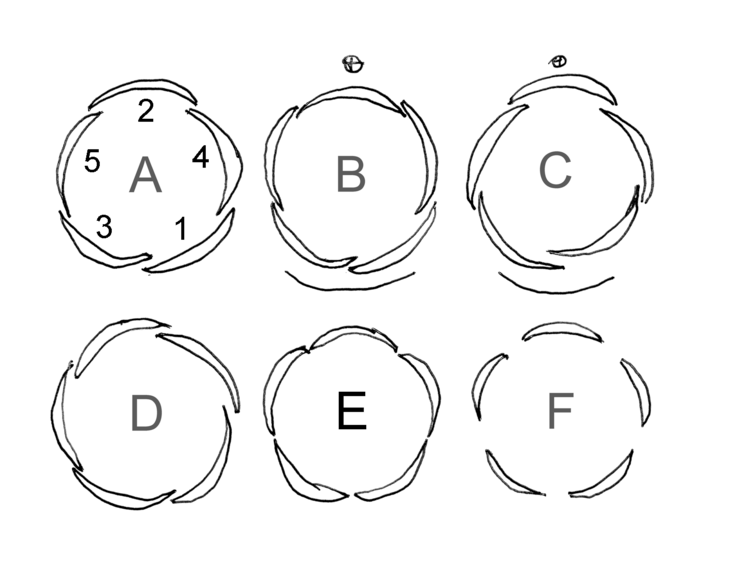|
Caesalpinaceae
Caesalpinioideae is a botanical name at the rank of subfamily, placed in the large family Fabaceae or Leguminosae. Its name is formed from the generic name ''Caesalpinia''. It is known also as the peacock flower subfamily. The Caesalpinioideae are mainly trees distributed in the moist tropics, but include such temperate species as the honeylocust (''Gleditsia triacanthos'') and Kentucky coffeetree (''Gymnocladus dioicus''). It has the following clade-based definition: The most inclusive crown clade containing ''Arcoa gonavensis'' Urb. and ''Mimosa pudica'' L., but not ''Bobgunnia fistuloides'' (Harms) J. H. Kirkbr. & Wiersema, ''Duparquetia orchidacea'' Baill., or '' Poeppigia procera'' C.Presl In some classifications, for example the Cronquist system, the group is recognized at the rank of family, Caesalpiniaceae. Characteristics * Specialised extrafloral nectaries often present on the petiole and / or on the primary and secondary rachises, usually between pinnae or leaflet ... [...More Info...] [...Related Items...] OR: [Wikipedia] [Google] [Baidu] |
Caesalpinia
''Caesalpinia'' is a genus of flowering plants in the family Fabaceae. Historically, membership within the genus has been highly variable, with different publications including anywhere from 70 to 165 species, depending largely on the inclusion or exclusion of species alternately listed under genera such as ''Hoffmannseggia''. It contains tropical or subtropical woody plants. The generic name honours the botanist, physician, and philosopher Andrea Cesalpino (1519–1603). The name Caesalpinaceae at family level, or Caesalpinioideae at the level of subfamily, is based on this generic name. Species * '' Caesalpinia acapulcensis'' Standl. * ''Caesalpinia anacantha'' Urb. * '' Caesalpinia bahamensis'' Lam. * ''Caesalpinia barahonensis'' Urb. * ''Caesalpinia brasiliensis'' L. * '' Caesalpinia cassioides'' Willd. 1809 *''Caesalpinia erianthera'' Chiov. * ''Caesalpinia monensis'' Britton—black nicker * ''Caesalpinia nipensis'' Urb. * ''Caesalpinia ... [...More Info...] [...Related Items...] OR: [Wikipedia] [Google] [Baidu] |
Delonix Regia
''Delonix regia'' is a species of flowering plant in the bean family Fabaceae, subfamily Caesalpinioideae native to Madagascar. It is noted for its fern-like leaves and flamboyant display of orange-red flowers over summer. In many tropical parts of the world it is grown as an ornamental tree and in English it is given the name royal poinciana, flamboyant, phoenix flower, flame of the forest, or flame tree (one of several species given this name). This species was previously placed in the genus ''Poinciana'', named for Phillippe de Longvilliers de Poincy, the 17th-century governor of Saint Christopher (Saint Kitts). It is a non-nodulating legume. Description The flowers of ''Delonix regia'' are large, with four spreading scarlet or orange-red petals up to long, and a fifth upright petal called the standard, which is slightly larger and spotted with yellow and white. They appear in corymbs along and at the ends of branches. The naturally occurring variety ''flavida'' (Beng ... [...More Info...] [...Related Items...] OR: [Wikipedia] [Google] [Baidu] |
Recordoxylon
''Recordoxylon'' is a genus of flowering plants in the legume family, Fabaceae. It belongs to the subfamily Caesalpinioideae. Currently, there is no commercial usage for it, not as decoration nor for its nutritive properties. The genus name of ''Recordoxylon'' is in honour of Samuel J. Record (1881–1945), an American botanist who played a prominent role in the study of trees and wood Wood is a porous and fibrous structural tissue found in the stems and roots of trees and other woody plants. It is an organic materiala natural composite of cellulose fibers that are strong in tension and embedded in a matrix of lignin th .... It was first described and published in Trop. Woods Vol.39 on page 16 in 1934. Its native range is northern South America and is found in northern Brazil, Colombia, French Guiana, Guyana and Venezuela. Species References Cassieae Plants described in 1934 Flora of Guyana Flora of North Brazil Flora of Colombia Flora of French Guiana ... [...More Info...] [...Related Items...] OR: [Wikipedia] [Google] [Baidu] |
Melanoxylum
''Melanoxylum'' is the genus Genus ( plural genera ) is a taxonomic rank used in the biological classification of living and fossil organisms as well as viruses. In the hierarchy of biological classification, genus comes above species and below family. In binomial nom ... for a yellow-flowered, Brauna tree of Brazil. References Cassieae Fabaceae genera {{Caesalpinioideae-stub ... [...More Info...] [...Related Items...] OR: [Wikipedia] [Google] [Baidu] |
Chamaecrista
''Chamaecrista'' is a genus of flowering plants in the pea family, Fabaceae, subfamily Caesalpinioideae. Members of the genus are commonly known as sensitive pea. Several species are capable of rapid plant movement. Unlike the related genera '' Cassia'' and '' Senna'', members of ''Chamaecrista'' form root nodules. Species ''Chamaecrista'' comprises the following species, organized into sections, subsections, and series: Section ''Apoucouita'' Benth. Series Apoucouita * '' Chamaecrista aiarana'' (H.S.Irwin) H.S.Irwin & Barneby * '' Chamaecrista apoucouita'' (Aubl.) H.S.Irwin & Barneby * ''Chamaecrista aspidiifolia ''Chamaecrista'' is a genus of flowering plants in the pea family, Fabaceae, subfamily Caesalpinioideae. Members of the genus are commonly known as sensitive pea. Several species are capable of rapid plant movement. Unlike the related genera ' ...'' H.S.Irwin & Barneby * '' Chamaecrista bahiae'' (H.S.Irwin) H.S.Irwin & Barneby * '' Chamaecrista boyanii'' (H.S.I ... [...More Info...] [...Related Items...] OR: [Wikipedia] [Google] [Baidu] |
Cassia (genus)
''Cassia'' is a genus of flowering plants in the legume family, Fabaceae, and the subfamily Caesalpinioideae. Species are known commonly as cassias. Cassia is also the English common name of some species in the genus ''Cinnamomum'' of the family Lauraceae. Species of the genera '' Senna'' and ''Chamaecrista'' were previously included in ''Cassia''. ''Cassia'' now generally includes the largest species of the legume subtribe Cassiinae, usually mid-sized trees. Ecology ''Cassia'' species occur in a range of climates. Some can be utilized widely as ornamental plants. They have been used in reforestation projects, and species from desert climates can be used to prevent desertification. ''Cassia'' species are used as food plants by the caterpillars of many lepidopteran taxa. For example, the skipper ''Astraptes fulgerator'' and the pierids ''Catopsilia pomona'' and '' C. pyranthe'' are all seen on ''Cassia fistula''. The latter utilizes several other cassias, as well. The plant ... [...More Info...] [...Related Items...] OR: [Wikipedia] [Google] [Baidu] |
Batesia
''Batesia'' is a genus of flowering plant Flowering plants are plants that bear flowers and fruits, and form the clade Angiospermae (), commonly called angiosperms. The term "angiosperm" is derived from the Greek words ('container, vessel') and ('seed'), and refers to those plants th ...s in the legume family, Fabaceae. It belongs to the subfamily Caesalpinioideae. References Cassieae Fabaceae genera {{Caesalpinioideae-stub ... [...More Info...] [...Related Items...] OR: [Wikipedia] [Google] [Baidu] |
Root Nodule
Root nodules are found on the roots of plants, primarily legumes, that form a symbiosis with nitrogen-fixing bacteria. Under nitrogen-limiting conditions, capable plants form a symbiotic relationship with a host-specific strain of bacteria known as rhizobia. This process has evolved multiple times within the legumes, as well as in other species found within the Rosid clade. Legume crops include beans, peas, and soybeans. Within legume root nodules, nitrogen gas (N2) from the atmosphere is converted into ammonia (NH3), which is then assimilated into amino acids (the building blocks of proteins), nucleotides (the building blocks of DNA and RNA as well as the important energy molecule ATP), and other cellular constituents such as vitamins, flavones, and hormones. Their ability to fix gaseous nitrogen makes legumes an ideal agricultural organism as their requirement for nitrogen fertilizer is reduced. Indeed, high nitrogen content blocks nodule development as there is no benefit ... [...More Info...] [...Related Items...] OR: [Wikipedia] [Google] [Baidu] |
Seed
A seed is an embryonic plant enclosed in a protective outer covering, along with a food reserve. The formation of the seed is a part of the process of reproduction in seed plants, the spermatophytes, including the gymnosperm and angiosperm plants. Seeds are the product of the ripened ovule, after the embryo sac is fertilized by sperm from pollen, forming a zygote. The embryo within a seed develops from the zygote, and grows within the mother plant to a certain size before growth is halted. The seed coat arises from the integuments of the ovule. Seeds have been an important development in the reproduction and success of vegetable gymnosperm and angiosperm plants, relative to more primitive plants such as ferns, mosses and liverworts, which do not have seeds and use water-dependent means to propagate themselves. Seed plants now dominate biological niches on land, from forests to grasslands both in hot and cold climates. The term "seed" also has a general me ... [...More Info...] [...Related Items...] OR: [Wikipedia] [Google] [Baidu] |
Pollen
Pollen is a powdery substance produced by seed plants. It consists of pollen grains (highly reduced microgametophytes), which produce male gametes (sperm cells). Pollen grains have a hard coat made of sporopollenin that protects the gametophytes during the process of their movement from the stamens to the pistil of flowering plants, or from the male cone to the female cone of gymnosperms. If pollen lands on a compatible pistil or female cone, it germinates, producing a pollen tube that transfers the sperm to the ovule containing the female gametophyte. Individual pollen grains are small enough to require magnification to see detail. The study of pollen is called palynology and is highly useful in paleoecology, paleontology, archaeology, and forensics. Pollen in plants is used for transferring haploid male genetic material from the anther of a single flower to the stigma of another in cross-pollination. In a case of self-pollination, this process takes place from the anth ... [...More Info...] [...Related Items...] OR: [Wikipedia] [Google] [Baidu] |
Anther
The stamen (plural ''stamina'' or ''stamens'') is the pollen-producing reproductive organ of a flower. Collectively the stamens form the androecium., p. 10 Morphology and terminology A stamen typically consists of a stalk called the filament and an anther which contains ''microsporangia''. Most commonly anthers are two-lobed and are attached to the filament either at the base or in the middle area of the anther. The sterile tissue between the lobes is called the connective, an extension of the filament containing conducting strands. It can be seen as an extension on the dorsal side of the anther. A pollen grain develops from a microspore in the microsporangium and contains the male gametophyte. The stamens in a flower are collectively called the androecium. The androecium can consist of as few as one-half stamen (i.e. a single locule) as in '' Canna'' species or as many as 3,482 stamens which have been counted in the saguaro (''Carnegiea gigantea''). The androecium in var ... [...More Info...] [...Related Items...] OR: [Wikipedia] [Google] [Baidu] |
Aestivation (botany)
Aestivation or estivation is the positional arrangement of the parts of a flower within a flower bud before it has opened. Aestivation is also sometimes referred to as praefoliation or prefoliation, but these terms may also mean vernation: the arrangement of leaves within a vegetative bud. Aestivation can be an important taxonomic diagnostic; for example Malvaceae flower buds have valvate sepals, with the exception of the genera ''Fremontodendron'' and ''Chiranthodendron ''Chiranthodendron'' is a flowering plant genus in the family Malvaceae. It comprises a single species of tree, ''Chiranthodendron pentadactylon''. Names The tree is called the devil's, monkey's or Mexican hand tree or the hand-flower in English ...'', which have sometimes been misplaced as a result. Terminology The terms used to describe aestivation are the same as those used to describe leaf vernation. Classes of aestivation include: * ''crumpled'' * '' decussate'' * ''imbricate'' – overlapping ** ''co ... [...More Info...] [...Related Items...] OR: [Wikipedia] [Google] [Baidu] |





